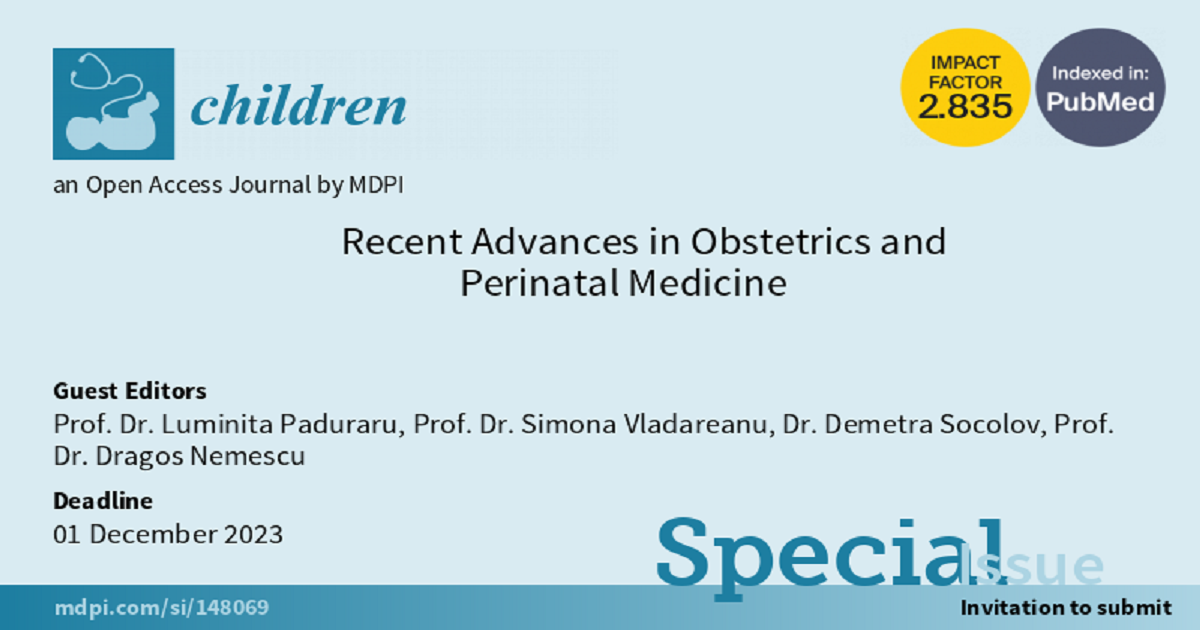Recent Advances in Obstetrics and Perinatal Medicine
A special issue of Children (ISSN 2227-9067). This special issue belongs to the section "Pediatric Neonatology".
Deadline for manuscript submissions: closed (1 December 2023) | Viewed by 12246

Special Issue Editors
Interests: neonatology; neonatal intensive care; twins; neonatal resuscitation; simulation; human milk; neurological and sensorial neonatal outcome; neonatal screening; medical training; head ultrasound; antenatal corticotherapy
Interests: neonatology; perinatology; neonatal point of care ultrasound; medical malpraxis; healthcare quality management
Interests: perinatology; ultrasound in obstetrics and gynecology; fetal medicine
Interests: prenatal diagnosis; fetal ultrasound; fetal therapy; preeclampsia; fetal growth restriction; endometriosis; laparoscopy
Special Issues, Collections and Topics in MDPI journals
Special Issue Information
Dear Colleagues,
Research in high-risk pregnancies has increased in recent years, being highlighted and treated by obstetricians, perinatologists, and neonatologists, with the contribution of co-related specialties involved in the care of mothers and newborns. Assisted reproductive techniques, progress in neonatal care, and widespread guidelines and protocols both in obstetrics and neonatology have contributed to decreasing the limit of viability to 22 weeks’ gestation in developed countries and 24-26 weeks’ gestation in low-income countries. This is a significant development; however, a real burden is placed on the individual, their family, and the healthcare and social systems in low-income countries, considering that the long-term outcome of neonates from a high-risk pregnancy may be impaired by severe sequels.
This Special Issue aims to gather scientific evidence relating to care of the mother and child, according to recent advances in their quality of their life, with a focus on interdisciplinary teamwork, from conception to the later neurodevelopment of a child. We welcome all researchers to take part in this effort and share their experience and novel and ongoing research through this Special Issue.
Please visit the Instructions for Authors before submitting a manuscript (https://www.mdpi.com/journal/children/instructions). We welcome your submission.
Prof. Dr. Luminita Paduraru
Prof. Dr. Simona Vladareanu
Dr. Demetra Socolov
Prof. Dr. Dragos Nemescu
Guest Editors
Manuscript Submission Information
Manuscripts should be submitted online at www.mdpi.com by registering and logging in to this website. Once you are registered, click here to go to the submission form. Manuscripts can be submitted until the deadline. All submissions that pass pre-check are peer-reviewed. Accepted papers will be published continuously in the journal (as soon as accepted) and will be listed together on the special issue website. Research articles, review articles as well as short communications are invited. For planned papers, a title and short abstract (about 100 words) can be sent to the Editorial Office for announcement on this website.
Submitted manuscripts should not have been published previously, nor be under consideration for publication elsewhere (except conference proceedings papers). All manuscripts are thoroughly refereed through a single-blind peer-review process. A guide for authors and other relevant information for submission of manuscripts is available on the Instructions for Authors page. Children is an international peer-reviewed open access monthly journal published by MDPI.
Please visit the Instructions for Authors page before submitting a manuscript. The Article Processing Charge (APC) for publication in this open access journal is 2400 CHF (Swiss Francs). Submitted papers should be well formatted and use good English. Authors may use MDPI's English editing service prior to publication or during author revisions.
Keywords
- newborn
- obstetrics
- multiple pregnancies
- prematurity
- screening in neonatology
- neurodevelopmental follow-up
- neonatal intensive care
- limits of viability
- congenital malformation
- assisted reproduction techniques
- high-risk pregnancy






